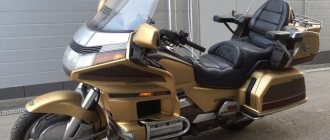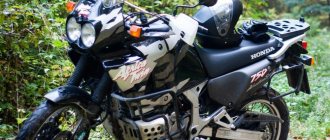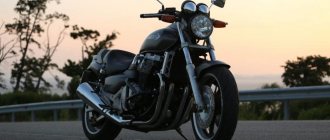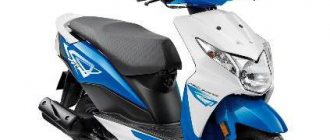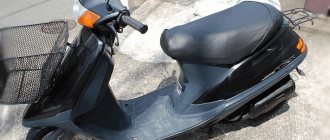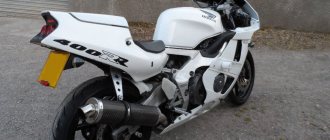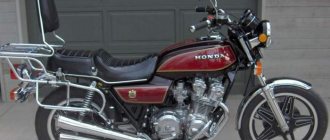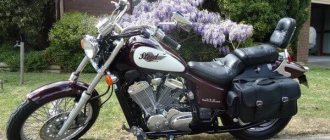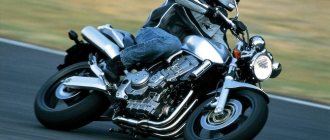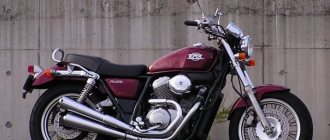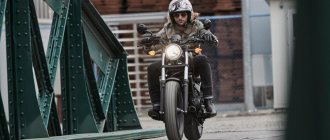Japanese motorcyclesHonda motorcycles
Among lovers of long trips along “breezy” roads, motorcycles of the “sport-tourism” class are especially popular.
Bikes of this class combine the high revs and speed of a sports motorcycle with the convenience of a “tourist”. And one of the leading positions in this class is held by the Japanese model Honda VFR 800.
Story
But before describing this now legendary motorcycle, a little history. And it begins in 1983, when designers designated VF750 Interceptor.
The name Interceptor stuck with American consumers for subsequent generations of the bike.
For themselves and the Europeans, they left only an alphanumeric index. The VF750 was the ancestor of Honda's sport-tourer class.
In 1986, the first of the VFRs appeared, still with the same index 750, indicating engine size.
Afterwards there were several generations of this model. And in 1998, 750 cc engines were abandoned, and then the first Honda VFR 800 appeared, with a completely new injection engine and a body kit borrowed from the Honda VTR1000.
Because of this, the Japanese did not introduce a new series of motorcycles into the classification, so the released VFR 800 is the 5th generation of the VFR family motorcycle.
But if you start counting from the first appearance of the VFR 800, then this model now has 3 generations.
The first VFR 800 did not last very long; an updated model appeared in 2002. The second VFR 800 has undergone some technical changes - a VTEC timing system has appeared.
Which was later reconfigured somewhat. This version was also updated somewhat externally and received two exhaust pipes running under the seat.
Nina's VFR 800 model is the third generation, it appeared in 2014. The general concept of the motorcycle remained unchanged, only the appearance was redone, they returned to one exhaust pipe, and the engine was slightly modernized. The latest model of this bike will be discussed below.
Why Honda VFR 800
It was not in vain that we chose this particular motorcycle for review, and now we will explain why. Firstly, the Japanese company Honda has always been famous for the quality and reliability of the vehicles they sell. It is in Honda motorcycles that you will find unsurpassed quality in all details, reliability of the engine and other power units, and of course, an impressive design. Secondly, motorcycles of this brand, which may be more than 15 years old, will be much more practical and convenient than new Chinese technology. We can guarantee you that the Honda VFR 800 will serve you much longer than a Chinese bike of dubious production, and even more so, it will give you more pleasant experiences from owning and operating a motorcycle.
Appearance
The VFR 800 initially seems quite wide; plastic body kits give it volume.
However, upon closer inspection, it is not that wide. But the existing body kits give a smooth shape, which is important for aerodynamics.
These body kits completely cover the front part, so of all the engine elements you can only see the radiator, and even then - in the front part, behind the wheel.
The V-shaped double headlight at the front gives the motorcycle a certain predatory appearance . A transparent fairing rises up from the headlights, behind which is a digital instrument panel.
Behind the steering clip-ons there is a “humpbacked” tank, providing the driver with a reclining position.
Due to the volume of the tank, the double seat is located almost entirely on the rear fender. Starting from the seat level, you can at least slightly examine the design; the frame and elements of the rear suspension appear.
On the right side there is a single exhaust pipe.
One of the most successful motorcycles from the global brand, Honda, is the XR 600 R, let’s look at its characteristics.
You can evaluate the range of Honda ATVs in our topic: https://themoto.net/atv/yaponskie-atv/honda-atv/obzor-modeley.html
Improvements continue
Many fans of the VFR 800 model were disappointed by the introduction of a chain drive timing mechanism instead of the previous gear one, which was used on the legendary RC-45 motorcycle. The arguments put forward in favor of the innovation looked unconvincing. The only advantage that could be seen was that the mechanism became simpler.
The designers had to actually prove they were right, conduct public testing and convince skeptics of the merits of the chain drive. At the same time, the gearbox was modernized. The first gear was shortened for acceleration parameters, and the remaining five were made longer.
The brake system of the new modification was reconfigured, the pressure was reduced, and already when you press the lever located on the steering wheel, the rear circuit operated more softly.
The motorcycle frame has become several hundred grams heavier due to strengthening of the rear suspension mounting brackets. The parameters of the front fork stays were increased, their diameter was 43 millimeters versus the previous 41 mm. The volume of the gas tank has expanded by one liter. All these technical improvements added about three kilograms to the motorcycle, but its reliability increased.
In 2003, the motorcycle was equipped with an ABS anti-lock brake system, which is very useful for sports touring models, as it is included in the list of the most effective devices in the active safety category. The weight of the car increased again, but with a sufficiently powerful engine this factor did not matter much.
Technical part
Now a little about the technical component of the bike. Initially, motorcycles of the VFR family were equipped with a 4-cylinder V-twin engine with liquid cooling.
The VFR 800 is no exception. But this model’s engine is already more high-tech, equipped with a fuel injection system and VTEC timing system.
The suspension was also revised. The front uses a cartridge-type telescopic fork with gas-filled shock absorbers. But at the rear there is an oil monoshock absorber with stepless adjustment.
The front wheel is equipped with a double-disc brake mechanism with 4-piston calipers. At the rear, the brake mechanism is a single disc with a 2-piston caliper. All this is complemented by the ABS system.
Model history
1998 - start of production and sales. The first generation is RC46. Model: Honda VFR800Fi (Interceptor) (Japan, Europe, North America, Australia). Frame/Engine Number: RC46~. Factory designation: VFR800FIW.
1999 - no significant changes. Model: Honda VFR800Fi (Interceptor) (Japan, Europe, North America, Australia). Frame/Engine Number: RC46~. Factory designation: VFR800FIX.
2000 - the model receives a HECS3 catalyst - Honda Evolutional Catalyzing System 3. Model: Honda VFR800Fi (Interceptor) (Japan, Europe, North America, Australia). Frame/Engine Number: RC46~. Factory designation: VFR800FIY.
2001 - no significant changes. Model: Honda VFR800Fi (Interceptor) (Japan, Europe, North America, Australia). Frame/Engine Number: RC46~. Factory designation: VFR800FI1.
2002 - restyling of the model. Second generation - RC46. The model gets a new look, a new instrument panel with an LCD screen, ABS as an option, new cylinder heads with a chain drive (instead of gears) and a VTEC system (activated from 6800 rpm). New generation of injection system (PGM-Fi) and new generation of combined braking system (CBS). The appearance of an immobilizer (HISS). The fuel tank capacity increases: 21 → 22 l. Transmission ratios change. Model: Honda VFR800F (Interceptor) + ABS (Japan, Europe, North America, Australia). Frame/Engine Number: RC46~. Factory designation: VFR8002 + VFR800A2.
2003 - no significant changes. Model: Honda VFR800F (Interceptor) + ABS (Japan, Europe, North America, Australia). Frame/Engine Number: RC46~. Factory designation: VFR8003 + VFR800A3.
2004 - the model receives an emergency warning button. Model: Honda VFR800F (Interceptor) + ABS (Japan, Europe, North America, Australia). Frame/Engine Number: RC46~. Factory designation: VFR8004 + VFR800A4.
2005 - no significant changes. Model: Honda VFR800F (Interceptor) + ABS (Japan, Europe, North America, Australia). Frame/Engine Number: RC46~. Factory designation: VFR8005 + VFR800A5.
2006 - no significant changes. Model: Honda VFR800F (Interceptor) + ABS (Japan, Europe, North America, Australia). Frame/Engine Number: RC46~. Factory designation: VFR8006 + VFR800A6.
2007 - no significant changes. Model: Honda VFR800F Interceptor + ABS (North America). Frame/Engine Number: RC46~. Factory designation: VFR800 AC, VFR800 2AC + VFR800A AC, VFR800A 2AC.
2008 - no significant changes. Model: Honda VFR800F (Interceptor) + ABS (Japan, Europe, North America, Australia). Frame/Engine Number: RC46~. Factory designation: VFR8008 + VFR800A8.
2009-2013 - no significant changes. Model: Honda VFR800F (Interceptor) + ABS (Japan, Europe, North America, Australia). Frame/Engine Number: RC46~. Factory designation: VFR8009 + VFR800A9.
2014 - restyling of the model. Third generation - RC79. The model gets a new appearance, an electronic speedometer, a new exhaust, a new braking system: larger brake discs (296 → 310 mm), 4-piston radial calipers with ABS (as standard). Fuel tank capacity decreases: 22.0 → 21.2 l. New suspension: HMAS fork with adjustable rebound, rear adjustable gas-oil monoshock. The Traction Control System (TCS) appears. New touring options: height-adjustable saddle, heated grips, automatic turn signals. Model: Honda VFR800F (Interceptor) + ABS (Japan, Europe, North America, Australia). Frame/Engine Number: RC79~. Factory designation: VFR800FE.
2015 - no significant changes. Model: Honda VFR800F (Interceptor) + ABS (Japan, Europe, North America, Australia). Frame/Engine Number: RC79~. Factory designation: VFR800FF.
2016 - no significant changes. Model: Honda VFR800F (Interceptor) + ABS (Japan, Europe, North America, Australia). Frame/Engine Number: RC79~. Factory designation: VFR800FG.
2017 - minor changes to the model. New exhaust system (increased maximum power to 107 hp and torque to 77 Nm). The standard configuration includes a 12V socket in the glove compartment. A 5-step windshield adjustment appears. Model: Honda VFR800F (Interceptor) + ABS (Japan, Europe, North America, Australia). Frame/Engine Number: RC79~. Factory designation: VFR800FH.
2018 - no significant changes. Model: Honda VFR800F (Interceptor) ABS (Europe). Factory designation: VFR800FJ.
2019 - no significant changes. Model: Honda VFR800F (Interceptor) ABS (Europe, Japan). Factory designation: VFR800FK.
Specifications
| Options | Unit change | Index |
| Length | mm | 2134 |
| Width | mm | 768 |
| Height | mm | 1204 |
| Seat height | mm | 789-809 |
| Wheelbase | mm | 1460 |
| Curb weight | kg | 239 |
| Power point | type | 4-cylinder, V-shape |
| Combustion chamber volume | cube cm. | 782 |
| Power | hp | 106 |
| S-ma cooling | type | Liquid |
| S-ma nutrition | type | Fuel injection |
| Start date | type | Email starter |
| Transmission | type | 6-speed, mech. |
| Drive unit | type | Chain |
| Tank capacity | l | 20,8 |
| Maximum speed | km/h | 235 |
Price
Thanks to its balance and good road behavior, the Honda VFR 800 is now quite popular, so its production has not yet stopped.
Therefore, it is possible to purchase a completely new motorcycle from the office. dealers, but its cost is not so small - 790 thousand rubles.
For those who cannot afford such a sum, the secondary market can be a help, where you can purchase this bike with different years of manufacture and technical condition. The cost of a Honda VFR 800 in this market ranges from 150 to 500 thousand rubles.
A chic “cruiser” made in the English style Yamaha drag star 1100, high reliability, soft suspension and much more.
Check out the technical characteristics of the Honda CBR 600 RR on the pages of our website.
Honda Interceptor 2014 motorcycle review
Honda's popular 800cc bike with a V-shaped four-cylinder engine is better than ever.
Some bikes arrive with shock and awe and power never seen before in a street bike. Getting off a bike like this feels like the gravitational constant has changed its value, and you'll never look at the bike the same way again.
The 2014 Honda Interceptor is not that kind of motorcycle. He wasn't made like that. No part or aspect of this new model is groundbreaking or radically new to the motorcycle industry. The Interceptor gradually captivates, making it clear that this latest version of Honda's 800cc V-four is an incredibly capable bike, worthy of being the successor to the much-loved VFR range.
The Interceptor returns in two colors: white and red, dubbed "VFR Red".
Family Legacy
At first glance, the 2014 Interceptor looks very, very familiar. The new body features the same familiar lines, but the design is sleeker and more stylish. The side radiators have been replaced with front ones, so where the bike previously had gills, there is stylish plastic. A side-mounted muffler replaces the underseat exhaust for reduced weight and a lower center of gravity. And even with the exhaust pipe hanging on the side, the motorcycle gives the impression of a narrower and more aerodynamic bike.
The dimensions confirm these guesses: the fairing, for example, has become 38 millimeters narrower. The shape of the seat makes the Interceptor feel even narrower than its predecessor. Even if you don't adjust the seat, changing the standard height from 807 millimeters to 787 millimeters, the ground seems to be closer. Shorter riders will only need to remove two anchors and lower two plates to lower the seat for a more comfortable position.
The Interceptor is powerful enough for a sporty driving style.
While working on the design and profile of the new Interceptor, Honda designers took the opportunity to work on the "skeleton" of the motorcycle and shed a few pounds from the predecessor model (which already seemed a little obese). The result of this work is a new subframe made of die-cast aluminum, which, thanks to the absence of an exhaust pipe under the seat, was able to “lose” 2 kilograms in comparison with its steel predecessor. This change greatly improves the vehicle's weight distribution and lowers the center of gravity for sportier handling and cornering agility.
For a low center of gravity, it was decided to abandon the installation of the exhaust pipe under the seat.
The chassis retains its basic hingeless aluminum frame with two side members. The engine is still mounted as the load-bearing element, while the new swingarm is coupled to the engine housing for greater strength and rigidity. Like the Honda VFR1200F , the swingarm plays a key role in the Pro-Arm rear suspension design with its Pro-Link shock absorber. The mounts retain their 43mm diameter, but the Showa fork internals have been redesigned and the sliders have been redesigned to accommodate radial mounts for Tokico four-piston calipers.
Large 310mm front discs (previously 296mm) are attached to new, lighter alloy wheels. The hollow 10-spoke wheels are made from high-quality die-cast alloy. To attract attention, the wheels also have a bronze finish, reminiscent of magnesium racing wheels. Many key parts of the Interceptor (crankshaft cover, engine side covers, triple clamp and handlebar) are finished in this color scheme, giving the bike a striking look and visual connection to the VFR's racing roots.
Bronze trim on the wheels and some parts of the engine and chassis enhances the Interceptor's appearance.
Engine compartment
Changes to the Interceptor's V-four engine were aimed at improving power delivery. At the manufacturer's meeting with journalists, there was no mention of an increase in power, which is extremely unusual for such press conferences. The emphasis was on torque at low and mid-range speeds.
The radiators (yes, there are still two of them) are again in front of the engine, where they belong.
The Interceptor engine capacity is 782 cubic centimeters, cylinder diameter is 72 millimeters, piston stroke is 48 millimeters; This is a V-shaped four-cylinder engine with a 90-degree cylinder camber angle and two camshafts in the cylinder head. The high-pressure cylinder liners are finished with a ceramic and graphite coating to reduce friction, wear and temperatures. The light weight of the chain-driven camshaft system is important for a sportsbike, but we still miss the mechanical sound of the gear design on older VFRs a little.
The magic of the Interceptor engine happens in the cylinder heads. Since 2002 (when the motorcycle was still called the VFR800 Interceptor), the engine has used the Honda VTEC valve control system. Below 7,000 rpm, only two of the four valves per cylinder are activated, allowing exhaust gases to flow in at a faster rate, since only one valve is used per intake and exhaust. Above 7000 rpm, all four valves operate normally. This operating arrangement ensures optimal torque delivery and economical gas mileage at low rpm, without sacrificing power and fun performance at high rpm. Oh yes, and the engine growls amazingly when it opens wider to gulp in more air and fuel.
The LED headlight shines incredibly brightly with a bluish light. The X-shaped shape of its body cannot be confused with anything.
For the 2014 model year, Honda focused on complaints about previous-generation models. For example, activation of the VTEC system was very abrupt. If this happened while cornering, it made smooth throttle control much more difficult and could even tilt the chassis. According to the manufacturer, the designers worked to improve power at low and mid-range speeds, as well as soften the response of the motorcycle when VTEC is turned on. New cam profiles were created, intake pipes were lengthened and the PGM-FI fuel injection system was optimized to accommodate these changes.
In addition, cool, dense air on the left side of the radiator is redirected to the air intake to improve power output. On the exhaust side of the engine, the new exhaust pipe has lost 5 kilograms compared to the high-mounted double muffler of the previous generation. Reducing weight is no worse than increasing the number of horsepower, and in some ways even better, since a lighter motorcycle is easier not only to accelerate, but also to brake.
Additional buttons on the left handlebar and front suspension adjusters make it clear that this is a Deluxe model. While a lot of information is visible on the instruments, the display's output is switched by buttons that are not very conveniently located behind the clutch master cylinder.
But let's return to VTEC. During aggressive driving, the increase in power with all valves turned on is noticeable - both in its delivery and in the characteristic roaring sound reaching the driver from the place between the dashboard and the gas tank. The sound is simply amazing! At high speeds, VTEC shifts are almost imperceptible.
However, in city traffic at low speeds, the VTEC system can behave rather strangely. If you drive in first gear at a constant speed, partially squeezing the throttle, and allow the revs to build up to the transitional 7,000 rpm, the engine will sometimes jerk quite violently as the extra valves activate. This doesn't happen all the time, but often enough to notice.
The Deluxe model comes with ABS, but the big news is that the Interceptor no longer has coupled brakes.
Deluxe – what does it mean?
For 2014, the Interceptor line consists of two models: the basic version and the Deluxe.
The two main advantages of the Deluxe model are ABS and traction control. Both of these technologies are already sufficiently developed and widespread that they are expected on a premium motorcycle. Don't listen to the old-fashioned Luddites: the presence of these systems is only good for a street bike, and their presence should be pleasing. In addition, the traction control system can be turned off by pressing a button on the left handlebar.
Additional systems on the Deluxe model are controlled by the left handlebar. The traction control switch is visible to the naked eye, but the heating button is more hidden.
The importance of ABS was demonstrated during a press test drive when one of the journalists entered a corner with poor visibility, slammed hard on the brakes, and ended up with dirt on the asphalt. ABS prevented him from locking up the front wheel, giving him time to decide whether to stop the bike in the rutted area or steer out of the corner. Without anti-lock braking, he likely wouldn't have time to choose.
The Interceptor Deluxe also features slightly improved suspension, with rebound and preload adjustable on the fork, and a conveniently located preload adjuster for the shock (in addition to the standard preload and rebound adjusters).
The hydraulic shock preload adjuster is conveniently hidden behind the left passenger footrest on the Deluxe model.
Convenience items like a center stand are also included on the Deluxe model. Add to this the heated grips with five levels of adjustment, switchable with the left thumb. Using technology introduced earlier this year on the 2014 Valkyrie , self-canceling turn signals are part of the ABS package, as both systems are powered by wheel sensors. None of these switching systems are perfect, but this new system is quite feasible in real-world applications.
Some convenient technologies are present on both the standard and Deluxe models. The convenient gear indicator is mechanical, not electronic, which determines the gear based on engine speed and rpm. This means that there is no delay after the gear shift for the indicator to calculate it, and when the clutch is disengaged, the indicator does not turn off. Nice little thing.
The dashboard is well thought out and conveniently organized. The large, centrally located tachometer dial is easy to read. The indicators are located at the top of the instrument panel, framing the tachometer. The LCD screen to the left of the tachometer includes a fuel gauge bar and speedometer. The right LCD screen becomes necessary during long races. On top there is an odometer, two trip meters and a countdown counter. It does not show the number of miles until the gas tank is empty, which would be convenient. Instead, it counts down from the number of miles manually specified by the driver (from 0 to 999.9).
The bag fastenings are in place, but do not attract unnecessary attention.
The middle row of numbers on the LCD screen shows the following: current miles per gallon, average miles per gallon, coolant temperature and ambient temperature. What's interesting is that the averages are linked to two trip meters per trip, meaning you can maintain two averages for your current gas tank and for a multi-day tour, for example. The clock is in the bottom row on the right LCD.
Having all this information at your fingertips is very convenient, but accessing it is not so easy due to the strange placement of the buttons low on the left side of the dashboard, behind the clutch master cylinder. It's very un-Honda-like and makes it difficult to do mundane things like switching from ambient temperature to coolant temperature.
Landing
The Interceptor's riding position is comfortable and sporty. The footrest position is high enough, but not too high, which can sometimes cause your legs to become numb on long rides. The footpegs are also set back slightly so that the rider naturally leans forward to reach the controls. However, if this angle seems too much for you, Honda has additional handlebar posts that make the handlebars 14 millimeters higher and moved back 7 millimeters. Riders around 180cm tall will feel the wind somewhere around shoulder height, so the helmet will be in calmer air without turbulence. Again, Honda has a taller windshield sold separately that provides more wind protection.
These additional handlebar stays will move the handlebars 14mm higher and 7mm rearward for a more relaxed torso position.
The engine starts sharply and has excellent throttle response throughout the entire rev range. At low speeds the engine is compliant and not too powerful. Around town, agility at high revs is enough for the driver to remember that he has a V-shaped four-cylinder engine under his feet. Rising to the middle speed range, the engine begins to come to life.
After passing the 7000 rpm mark it becomes even more interesting. The engine sound turns into a roar when VTEC turns on all the valves, and intensifies to the maximum speed. But the Interceptor is still not a superbike designed for peak power. The emphasis is on “real world” performance, so to speak, applicable to city streets. In this regard, the engine is more than good.
The electronic fuel injection system works flawlessly in almost all situations, expertly managing the transitions from idle to acceleration and vice versa as the driver navigates a winding stretch of unknown road. Neutral throttle position is very easy to maintain. The transition from idle was harsh only when the revs were too low for high gear. In this case, the engine was so far out of its power band that it was impossible to get by without a couple of downshifts. It is worth mentioning that for a bike designed for low and medium speeds, the engine still prefers to operate at medium speeds and above.
What the motor doesn’t have any problems with is switching. The distance between gears is quite small, and the engine loves clutchless upshifts. A slipper clutch would be especially useful in sharp corners when the driver slams on the brakes and downshifts abruptly.
Honda couldn't have called this bike the Interceptor if it didn't have a single-sided swingarm. Dunlop Sportmax D222 tires performed well in false urban conditions.
Speaking of braking, the brakes on the Interceptor are powerful and, best of all, non-coupled. Now those who like to use the rear brake to regulate cornering speed can do so without the fear that applying the front brake will shift weight forward in the chassis. The brakes themselves adhere to the golden mean: they are not too hard, and not too soft, but provide just the amount of stopping power that the driver needs.
The same can be said about the steering of a motorcycle. It's not blazingly fast, but it's responsive enough to handle the twistiest bits of road with ease. There are always plenty of holes, bumps and obstacles on the roads that need to be avoided, and changing lanes when turning is carried out quickly and accurately. It's unlikely that Interceptor bikes will be used on race tracks, but the bike will certainly feel confident there too.
Front preload is easily adjustable. Please note that the adjuster requires an open-end wrench, not a closed-end wrench.
In the city and on the highway, the ride of the motorcycle is sporty, but not harsh. The bike feels comfortable when equipped with additional hard bags. Cruising down a country road at fairly sporty speeds, the suspension remains firm and transfers some road imperfections to the driver's hands, but larger bumps are absorbed quite well until they become large enough to tip the chassis. The suspension then oscillates for a few more cycles before settling down. On a very bumpy road, the suspension begins to fail and gives quite a kickback.
A slight adjustment to the rebound damping stabilized the bike over medium-sized bumps, but we never had the chance to test the new suspension settings on a bumpy road.
A shipping delay prevented us from trying out the Interceptor with the optional saddlebags.
Bottom line
Many previous CFR800 owners had used their bikes as sport-touring bikes with hard bags, and we were looking forward to testing the new bags and bindings, but the manufacturer didn't have them delivered in time for our introductory test drive. So we can't say anything about them, but otherwise the Interceptor is very, very good on the highway. The engine literally floats at 110 kilometers per hour in maximum gear and 5000 rpm. Vibration begins to be felt on the footpegs at approximately 6500 rpm, and around 7000 rpm it is also felt on the steering wheel. Average fuel consumption is approximately 5.6 liters per 100 kilometers, so on a full tank (volume of 21.2 liters) the Interceptor should confidently travel more than 350 kilometers.
The 2014 Interceptor should please both longtime VFR fans and newcomers.
Honda have brought back the Interceptor and it's in great shape. The manufacturer has dealt with the main problems of the motorcycle in the form of excess weight and abrupt switching of the VTEC system, providing the driver with an extremely pleasant and capable motorcycle. The manufacturer of a motorcycle of this type must trust the buyer to understand that in the case of such a machine, the main thing is not the first impression, but a gradual understanding of all the strengths of the bike and respect. As in any relationship, to be honest.
The 2014 Honda Interceptor will be available in white or red.
Convenient loops attached to the rear seat make it easier to secure and tie things down.
+ Pros
| — Minutes
|
Photo gallery
Thanks to its good build quality, the VFR 800 is still quite popular in its circles. The production of this bike continues to this day, we invite you to familiarize yourself with its changes from generation to generation. Enjoy watching.
